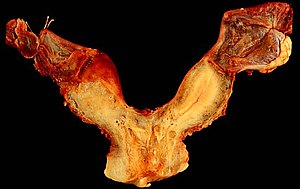Uterus duplex
| Uterine malformation | |
|---|---|
 |
|
| A human bicornuate uterus | |
| Classification and external resources | |
| Specialty | medical genetics |
| ICD-10 | Q51 |
| ICD-9-CM | 752.2-752.3 |
A uterine malformation is a type of female genital malformation resulting from an abnormal development of the Müllerian duct(s) during embryogenesis. Symptoms range from amenorrhea, infertility, recurrent pregnancy loss, and pain, to normal functioning depending on the nature of the defect.
The prevalence of uterine malformation is estimated to be 6.7% in the general population, slightly higher (7.3%) in the infertility population, and significantly higher in a population of women with a history of recurrent miscarriages (16%).
The American Fertility Society (now American Society of Reproductive Medicine) Classification distinguishes:
A uterine septum can be corrected by hysteroscopic surgery.
An additional variation is the arcuate uterus where there is a concave dimple in the uterine fundus within the cavity.
A rudimentary uterus is a uterine remnant not connected to cervix and vagina and may be found on the other side of an unicornuate uterus.
Patients with uterine abnormalities may have associated renal abnormalities including unilateral renal agenesis.
As the vagina is largely derived from the Müllerian ducts, lack of fusion of the two ducts can lead to the formation of a vaginal duplication and lack of absorption of the wall between the two ducts will leave a residual septum, leading to a "double vagina". This condition may be associated with a uterus didelphys or a uterine septum. Since the condition is internal and usually asymptomatic, a person may not be aware of having a "double vagina." If necessary, the partition can be surgically corrected, however, there is no valid medical reason for such a procedure.
...
Wikipedia
